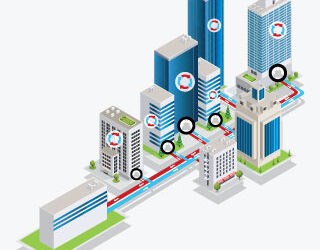Strengthening Commercial Building Energy Data Management in India

Background
A robust sector-wide energy consumption data is crucial for the policymakers to support decision making for influencing energy efficiency actions. The management of energy consumption data at a national level is a daunting task due to issues like availability of end-use data, large volume of data, ownership of data with different institutions, lack of systems and processes etc. To create an effective and comprehensive data management framework, it is essential to ensure periodic availability of the most updated, granular, consistent, reliable, easier to access, and bottom up data.
In India, the building sector comprises of residential and commercial spaces and is one of the second largest consumers of electricity and fuel sources. Also, the building floor space is projected to grow by 2.6 times by 2050 compared to 2015. According to IESS estimates, the energy consumption in buildings was 1292 TWh in 2017 which is expected to grow up to 2809 by 2047.
Within the building sector, the commercial buildings accounts for almost 33% of the total built space, and is expected to increase at a rate of 8-10% annually. This growth in the commercial space is propelled by the ongoing economic reforms, information technology (IT) revolution, growth in health care sector, urbanization resulting in increase in demand for commercial services, improved standards of living, and other factors. This growth in commercial buildings will be coupled with an increased demand for energy sources in the future. According to IESS, the commercial building energy consumption will grow by 6.6 times till 2047 from 97 TWh in 2017.
There are several policies and programs in place to decouple the commercial space growth and subsequent rise in energy demand. Government policies including Energy Conservation Building Code (ECBC), Star rating programme for buildings, Perform, and Achieve and Trade (PAT), Standards and labelling, among others have been initiated to meet the objective. However, effective implementation of these policies is always under question due to lack of data of bottom up data. Therefore, to evaluate the impact and effectiveness of the above policies it is essential that the data on consumption of different energy sources, energy use for different end-use applications, floor area growth, stock of energy consuming equipment etc. is made available regularly. This will enable in tracking the effectiveness of existing policies and providing insights in formulating new policy measures. Some of the use cases for granular end-use data in the commercial building sector are presented next.

Figure 1: Use cases for granular end-use data in commercial building sector
However, the existing data management framework in the country is not up to date. There are several issues and gaps in the data framework which has been recognized by institutions like NITI Aayog. To address these issues, NITI Aayog had constituted a sub-group for strengthening the energy consumption data in building sector in June 2018. The broad mandate was to assess the existing data management framework for buildings and recommend measures to strengthen it further. The next section investigates the status of data availability, categorisation framework, the key data gaps, with respect to commercial energy data management, and provides recommendations.
Current status of Commercial Energy Data Framework
This section describes the existing framework of commercial energy data and the consumer category structure, followed by different institutions.
Commercial energy data status
Several institutions including Central Electricity Authority (CEA), Ministry of Petroleum and Natural Gas (MoPNG), The Federation of Hotel and Restaurant Associations of India (FHRAI), Central Bureau of Health Intelligence (CBHI), Association of Healthcare Providers India (AHPI), and others are involved in the collection and dissemination of commercial energy data. The figure below represents the type of data shared by these institutions, source documents, and periodicity.

Figure 2: Commercial energy data collected and published periodically (MoSPI: Ministry of Statistics and Programme Implementation, ULBs: Urban Local Bodies, *data not available exclusively for commercial category)
Consumer categorisation by several institutions containing commercial energy data
The categorisation of commercial building consumers is inconsistent across institutions. Several institutions including Ministry of Housing and Urban Affairs (MoHUA), Bureau of Indian Standards (BIS), Central Electricity Authority (CEA), Bureau of Energy Efficiency (BEE), Urban Local Bodies (ULBs), and Distribution Companies (DISCOMs), have a varied basis for creating consumer categories. The table below represents the basis of classification and the category structure followed by the organisations mentioned above.
Table 1: Criteria for categorisation by different institutions from the perspective of commercial energy-related data
| Organisation | Basis of classification |
| MoHUA/BIS | Type of activity in the building |
| BEE | Functional requirement of building and energy use |
| CEA | Type of activity in the building |
| DISCOMs | Type of activity and electricity tariff for a particular building |
| ULBs | Type of activity and property tax rate for a particular building |

Figure 3: Category structure followed by different institutions important from the perspective of commercial energy-related data
- There is inconsistency in the categorisation by institutions, as shown in the table above. For example, MoHUA includes hospitals under the institutional category, whereas BEE has a separate category for buildings providing healthcare facilities.
- Moreover, inconsistency exists between the categorisation followed across all DISCOMs in the country. For example, government educational institutions fall under the Domestic category in Delhi and private educational institutions under the non-domestic category. Whereas, Kanpur has a separate category for public and private educational institutions.
- Variation also exists in the property tax categorisation by several ULBs across the country. Delhi has 30 broad categories for commercial buildings, Kanpur has 51 broad non-residential categories, and Pune has four main categories and five sub-categories for all commercial buildings.
- Due to variation in category structure across organisations and states, a compilation of datasets sourced from two different bodies at the state and/or national level to track energy efficiency progress is challenging.
Building key performance indicators for policy planning
The granular data is critical from the perspective of policy planning. However, as data collection is a resource-intensive process, it is essential to know the granularity we need to influence policy decisions. The pyramid below by International Energy Agency (IEA) represents the different levels of energy indicators. It recommends granularity until level three, essential for setting benchmarks, policy planning, and evaluation.

Figure 4: Building Key Energy Efficiency Indicators by IEA
| Level 1 indicators | Total energy consumption in commercial sector per unit activity variable |
| Level 2 indicators | Energy consumption in particular end-use applications, e.g. space cooling or lighting, per unit activity variable |
| Level 3 indicators | End-use energy consumption by equipment type / fuel type / commercial category type per unit activity variable |
| Activity variable | Depends on end-use or ease of data availability and can be floor area, number of persons occupying the room, number of hospitals beds, number of hotel rooms, etc. |
Challenges in existing data framework
As suggested earlier, existing data is incomplete in its relevance for policymaking. The challenges in the existing data management framework and institutional set up for estimating indicators till level three are thus highlighted below:
- Inconsistency in commercial building categorisation across institutions and states
- Lack of granular end-use data for policymaking, e.g. cooling energy consumption by floor area or technology type (multi-split air conditioning, VRF/VRV and others) or building sub-category type (hotels, hospitals, malls, educational institutes and others), lighting energy consumption by technology type (LED, CFL and others) or building sub-category type etc.
- Lack of consumption data on HSD and Kerosene
- Excluding a few organisations such as CBHI and FHRAI, no other organisation has a mandate to collect and disclose activity related data. There is no designated agency at the national level for coordination and compilation of floor area details contained with the ULBs.
- Delay in data dissemination of about 1-1.5 years by institutions disseminating data via the Energy Statistics report, PNG Statistics report, CEA General Review, etc.
Suggestions
The above given information somewhat helps us understand the gaps between existing and expected scenario of data management. To fill in the data gaps and enable policymakers for informed decision making, below given are some recommendations:
- MoHUA to take the lead in framework development for uniform categorisation of commercial buildings across organisations and states in line with the National Industrial Classification.
- MoHUA to take lead in leveraging the existing digital infrastructure such as GIS mapping and Digital Door Number (DDN) framework to create an energy depository at the national level. The ULBs can be mandated for disclosing floor area details collected for property tax estimation, and MoHUA can take the lead in compiling the data shared by several ULBs across the country at a national level.
- The institutional capacity of administrative bodies and survey agencies such as MoSPI, MoPNG, CEA can be strengthened for fast data collection, processing and dissemination.
- The existing surveys of National Sample Survey Office (NSSO) such as Annual Survey of Services Sector (ASSSE) can be strengthened for understanding energy consumption, at least for estimating indicators till level one.
- The existing institutional framework can be further strengthened for understanding energy consumption, however, there exists a limit for this. Hence, there is an urgent need for an exclusive “Commercial Building Energy Consumption Survey” to collect and disseminate granular end-use data till level three, useful for policy planning.
For an in-depth understanding of the existing commercial energy data management landscape in India, and ways to further strengthen it, refer to our report on “Commercial Energy Data Management”.
Shravani Itkelwar, Research Associate, Industrial Energy Efficiency
Shravani Itkelwar works in the Industrial Energy Efficiency vertical at AEEE. She is currently developing a framework for granular end-use building energy data and industrial decarbonisation pathways.




